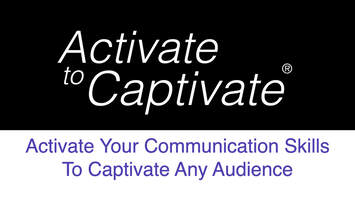|
In presentations, conferences, and meetings, people often don’t have enough time to cover all the content they want to share. That’s why we often hear phrases like:
“I’ll go through this quickly…” “To give you a ‘brief’ overview…” “I just have a quick question to ask…” However, even though these types of sentences are common, it’s important to understand the effect they actually have on an audience. “I’ll go through this quickly…” When someone says they will do something “quickly” it usually means the presenter will be speaking at a rapid pace. In order to keep up, the audience will have to put in more effort to track the details. Usually, this is when the audience decides to tune out. It’s more productive to simply omit that phrase and then share the corresponding content. “To give you a ‘brief’ overview…” Telling people something will be “brief” draws an audience’s attention to the time the content is taking, rather than the details of the content. This can invite critique because the audience starts to analyze whether the summary was succinct or if it dragged on too long. Eliminating that word is more direct and helps your message stand out. “I just have a quick question to ask…” When you’re already running low on time, saying something will be “quick” actually has the opposite effect. You don’t want to spend precious time adding in extra phrases when it would be better to spend that time on the discussion. That’s why I recommend avoiding that phrase and simply asking the question. This creates a smoother narrative which is a better use of everyone’s schedule. While it’s common to comment on how “quick” something will be, it’s not always effective. Instead, omit those phrases and simply share the content. This can help your audience connect with the information which will be a more effective use of everyone’s time. Author: Bri McWhorter The Q & A session of a presentation can be a great way to engage with an audience. However, sometimes a presenter may freeze in a situation where they are receiving more rigorous or abrasive questions. That’s because when we feel attacked, our brain goes into defense mode and it inhibits our ability to calmly analyze the question. Therefore, try these tips when encountering more "persistent" queries from audience members.
1. Reframe their aggression When someone’s delivery is more aggressive, it’s important to remember that they probably aren’t focusing on how they are asking the question. Instead, they are feeling confused and require assistance. This helps reframe the situation from an “attack” into an opportunity to help. 2. Relax your body When we are bracing for a question, we often tense before we respond. When you’re tense, you’re not able to think as easily. Instead, try exhaling before answering. Or, if you notice your jaw or shoulders are tight, try relaxing them. The more physically at ease you are, the more you’ll be able to think on your feet. 3. Remember you have options When we put a lot of pressure on a moment, it’s harder to think creatively. That’s why it’s important to remind yourself that there are options to follow up with someone. For example, you could email them and say, “Thanks for your interest in my work. I wasn’t able to come up with the response on the spot yesterday, but now that I’ve had some time I wanted to reach out.” Just because the event is over, doesn’t mean the opportunity to respond has ended. Whenever we have one of these moments, it’s tough. Try to reframe, relax, and remind yourself that you have multiple options to follow up with folks. Keeping these things in mind can help you feel more at ease and ready for questions. Author: Bri McWhorter Meetings take up a lot of time. Therefore, it’s important to make them as effective as possible. To prepare, folks spend time crafting agendas, putting together slide decks, and coming up with discussion points. People have to be intentional in order to maximize each meeting’s potential. However, there is one moment in a meeting that often gets overlooked — the end.
People usually conclude their meetings by saying: Well, it looks like we are out of time. I know that was a lot of information. So ya… guess that’s it. Then, that phrase becomes the last thing people hear and the message they replay in their head. A team shouldn’t be thinking about how that was “a lot of information” or how everyone ran “out of time”. Instead, it’s important to think about how to make that last moment count. For example a meeting could end with: I appreciate your time and I look forward to checking in next week. I’m excited to hear about the project updates on our next call. Thank you all for all the work you do. The end of a conversation matters. So before a call ends or folks walk out of a conference room, be intentional about the last phrase people hear. Author: Bri McWhorter Asking questions during a presentation can be a great way to engage your audience. It helps the speaker connect with the room and allows the audience to guide the narrative around topics they’d like to explore more. However, it’s becoming increasingly popular for speakers to ask rhetorical questions during presentations. Rhetorical questions, or questions where the speaker doesn’t actually need an answer from their audience, can undermine the power of a presentation for a number of reasons.
1. Disrupts flow Instead of making statements that connect to form a cohesive story, rhetorical questions disrupt the flow of a presentation. For example when a speaker says: So why did we do this? Well, we did this because… What is the new product? The new product is… Rhetorical questions create a choppy tone throughout a presentation. This stop/start pattern can also make it harder for the audience to follow along, since we tend to remember narratives that connect and flow together. Therefore, it’s better to avoid questions and make statements instead. For example… We did this because… The new product is… Making statements is a stronger way to connect ideas in a presentation. 2. Gives your audience permission to stay silent Rhetorical questions don’t require answers. Thus, when a speaker asks a lot of them, the audience gets accustomed to not answering or sharing a response. Then, when a speaker asks a question where they do want to elicit a response, the audience might not engage because they have fallen into a passive pattern and stay silent. 3. Questions can add in a hesitant tone When a speaker asks too many rhetorical questions, it can affect how solid their idea sounds. If an audience is going to trust that a new project or idea was well thought through, it’s better to make statements about how everything came together. Then, if someone does have a question it stands out as an avenue to explore. Having too many rhetorical questions can create a doubtful undertone throughout a presentation. Rhetorical questions can disrupt flow, make your audience disengage, and can add hesitation to your content. Instead, I recommend only asking questions when the audience can actually respond. By asking active questions, speakers show they value engagement by opening up a meaningful dialogue with their audience. Author: Bri McWhorter One of the most common small talk questions is, “What do you do?” People ask this question because it’s a quick and concise way to ask people how they spend the majority of their time. But often, this question doesn’t allow people to open up and connect.
Folks might answer: I’m a grad student at X university. I’m an attorney. I’m a Developer at X corporation. Some people will share a little about the type of work they do, but people are often quite succinct and don’t elaborate. This makes it hard to find an organic way to continue the conversation. That’s why I recommend following up by asking people about what aspects of their jobs (or their fields) that they appreciate. For example you could ask: What’s something you enjoy about your work at the moment? Are you noticing anything changing in your field right now? What is one of the best parts of your job? What is something about your current role that you find interesting? What’s something you look forward to when you work with your colleagues? We can always find ways to bond over stress and discomfort, but when you are meeting someone new, it’s good to connect over things that energize or intrigue you. If your goal is to get people to open up, think about also asking them to share things that inspire and motivate them. Author: Bri McWhorter Many speakers worry about forgetting what they want to say during a presentation. They don’t want to freeze in front of their audience. It can be a very surreal experience, to completely lose your train of thought in the middle of a talk. However, many people don’t realize that there are a few situations that can make it easier for someone to blank out.
1. Replaying a former rehearsal Some presenters are surprised when they practice a talk perfectly, and then when they do it live, they completely forget what they want to say. This can happen when a speaker is thinking about a former rehearsal as they start their current presentation. If you are trying to replay something you did in the past, your attention won’t be on the current moment. Instead, your brain goes back in time and this disconnect can often trigger a person to forget what they are actively saying. This happens to athletes as well. If they are thinking about a previous time when they shot a basket correctly, or a moment when they kicked a ball really well, they lose focus on what is in front of them and it affects their performance. Therefore, instead of trying to replay a former talk, just trust your rehearsals prepared you for the task at hand. Then focus on the present moment as you share your work with the audience in front of you. 2. Made sense on paper Another thing that throws presenters off is when they map out their transitions on paper, but they don’t work as well when they are spoken out loud. So if you’ve ever had a moment where you can’t remember the next part of your talk, it’s often because your last thought didn’t make you think of the next one. This happens to actors all the time. If they forget a line, it’s often because they don’t know why they need to share their next line. That’s why I recommend saying your transitions out loud without being able to look at the text. If you know how to begin and end each slide, you’re far more likely to have a consistent flow of ideas and remember your content. 3. Focusing on the words not the story When presenters try to memorize a presentation, they are focused on remembering text. However, that’s not how we tell stories. When we tell stories, the exact words aren’t important, it’s more about replaying images and events in our head. Instead of trying to memorize words, try to get comfortable with a sequence of events. Going into “storytelling mode” helps people remember their content as they connect with their audience. So if you’ve frozen during a presentation before, forget any former rehearsals, map out your transitions, and then go into storytelling mode. It will help you focus on the current moment so you can successfully share your work with others. Author: Bri McWhorter No matter how prepared you are, surprises happen. That’s why it’s difficult when people feel ready for a presentation, but then something happens when they get up in front of an audience and their nerves take over. Thankfully, there are things people can do during their presentation prep work that can help them practice dealing with these unexpected variables.
1. Practice in different environments People usually practice presentations in a familiar environment that they have full control over. However, when you go to a conference or a new location, the entire presentation set-up changes. You have a different visual in front of you, people might be moving or shuffling their stuff around, and you are no longer inches from your laptop in a quiet room. That’s why I recommend practicing parts of your presentation in different environments. See if you can practice in a new conference room, at a different desk with people around, even practice the transitions in your presentation as you walk around the block. If you can get comfortable with new variables around you as you share your talk, you’ll be far more prepared for your presentation. 2. Practice without looking at your slides or a script Every presentation setup is different. I’ve given hybrid presentations where my laptop is in the back of the room while I’m in front of a conference table. I had no access to notes and I couldn’t see what slide was coming up next. Thankfully I was very familiar with my topic and I didn’t need to access any notes. However, you don’t want to be thrown off if something like this happens to you. That’s why I always make sure I practice the outline of my presentation without looking at my slides. If you know what idea comes next without a visual reminder, you’ll feel prepared with and without your slides. 3. Practice having something go wrong While you can’t prepare for every situation that occurs, you can control how you react. If you’re worried about how you’ll handle curve balls, I recommend practicing having something go wrong. Click ahead a few slides and pretend you had a tech glitch, close your laptop in the middle of your presentation and pretend the screen projector turned off, or practice with a friend and have them interrupt you. The more you train yourself to stay calm, breathe, and continue the narrative, the more prepared you’ll be for future events. While you can’t prepare for every variable, you can practice handling them. Rehearse in different environments, go through your outline without looking at your script, or have something go awry on purpose. That way you’ll feel much more prepared for your next presentation. Author: Bri McWhorter During the PhD journey, one important milestone is the advancement to candidacy oral exam. This is where a student talks about the work they’ve done and the work they intend to complete in order to proceed to the PhD dissertation phase. The student prepares a presentation and their committee can interrupt and ask questions at any point. Then the committee votes as to whether the student has advanced to candidacy. Because of the talk’s unique nature and importance, many students get overwhelmed preparing for it.
That’s why I’ve put together three tips to help you reframe how you think about an advancement: 1. Right Mindset If you’ve had test anxiety in the past, anything called an "exam" will ignite stress. However, this is not an "exam" where you are checking boxes on a piece of paper — this is a conversation. Think of your committee as a panel of consultants who are there to look at the various components of your work and identify any blind spots that you might want to account for now, rather than deal with later. Think of this as a formal meeting where you get to discuss your project with some of the most brilliant people in your field and get their feedback. 2. Appreciate Questions Instead of worrying about questions from your committee, try to appreciate them. Your committee is asking questions about your work for a reason. They want to make sure your plan is solid before moving on to the next stage. It would be far worse if people knew there could be an issue with your dissertation, but didn’t tell you until it was too late. This is an opportunity to examine your plan from every angle before moving forward. 3. People Are Trying to Help Sometimes a committee member shares feedback in an unfiltered way and their vocal delivery can come off as harsh or judgmental. Whenever I work with people who are a bit more "direct" in their delivery, I like to assume they are coming from a protective mindset where they are focusing on the information, not on how they share it. For example, if a kid runs into the middle of the street, we might react with "No! Come back!" and forget to deliver that information in a gentle way. People on your committee are invested in your success. So if they ask questions that come off harshly, remember they are there to help you and have your back. If you are preparing for an advancement (or another oral exam), try to adjust your mindset, appreciate questions, and remember that your committee is there to help. Before you enter the room, shake off any nervous energy, breathe deep, and walk into that room with your head held high. Enjoy this time where brilliant people are taking time out of their day to help you succeed. Author: Bri McWhorter During a presentation, people share a substantial amount of information. Even though the audience is listening, sometimes a message might get missed. You don’t want people feeling that they need to make an effort in order to keep up. That’s why it’s important to be intentional about pausing during certain moments in a presentation.
1. In the introduction In the introduction, you need to give people a moment to get used to your voice, presence, and presentation style. If you share your ideas too quickly at the start, the audience has to work to keep up with you. Then, if they feel like they need to put in effort at the start (before the information gets complicated) people will just tune out. That’s why you want to pause between your ideas at the beginning, so that your audience has a moment to connect with you and your material. 2. Before you share important information People need a moment to process the last idea they heard. Therefore, if you are sharing important information, be sure to pause right before you share it. Otherwise, even if your message is clear, your audience might not hear it because they are still digesting the last thought. 3. When you share your contribution to a project Background information can easily get confused with new information. That’s especially true if someone is not familiar with the topic you are presenting. However, you want your effort to be acknowledged and stand out. Therefore, I recommend pausing before you share your contribution to a project to make sure it’s recognized. 4. Between slides Every time you click to a new slide, the audience needs a moment to process a new visual. If you talk over your slides, then the audience feels like they need to catch up. That’s why I recommend pausing every time you click to a new slide. It gives the audience a chance to process the new image before they refocus on your speech. 5. Before your last sentence A lot of presenters rush through the end of their presentation. When that happens, the audience doesn’t have time to digest the last thought before everything ends. Therefore, before your last sentence, be sure to take a moment and breathe before you share your last thought. Not only does this help the presentation feel more polished, but it also allows your conclusion to land much more effectively. Pauses are powerful. That’s why I recommend pausing during key moments of your talk. This way, you help your audience relax, process information, and enjoy listening to your presentation. Author: Bri McWhorter Some people have a difficult time sharing their achievements. While being humble is important, there are certain situations where you need to be able to talk about your success, like in a job interview or when you’re up for a promotion. Because if you can’t talk about what you’ve achieved, then it puts the pressure on other people to figure it out. That’s a lot to ask of someone else, especially if they don’t know you well. It’s also hard if a supervisor needs to advocate for you, if you can’t advocate for yourself. That’s why I’ve come up with a few phrases to help people share their accomplishments in an authentic and genuine way.
1. Looking back at myself five years ago, I’m proud to say that I’ve been able to… Thinking about how far you’ve come in your career is a great way to talk about your accomplishments. It’s a nice way to give yourself some perspective so that you can articulate your journey and highlight how much you’ve achieved. 2. I’m grateful that I had the opportunity to contribute to __________ project. Coming from a place of gratitude is useful in most situations. Especially since pompous people rarely bring up how thankful they are. Try using this phrase to help you bring up an achievement in an organic way. 3. When I look back on my career, some of the moments that stand out are…Accomplishments aren’t always attached to a particular project. They can be relationships that you’ve formed, people that you mentored, or even times you’ve invested in yourself — like going back to school to learn a new technique. Reflecting on your journey allows you to highlight experiences that have made an impact. Try using these phrases if you have a harder time bringing up your accomplishments. Using these responses can help other people understand your strengths, your career milestones, and give others a picture of what you might be able to achieve in a new role. Author: Bri McWhorter |
AuthorBri McWhorter is the Founder and CEO of Activate to Captivate. Categories
All
Videos
Archives
April 2024
|
Click to Contact
© 2014-2024 Activate to Captivate, LLC
All Rights Reserved
All Rights Reserved











 RSS Feed
RSS Feed
